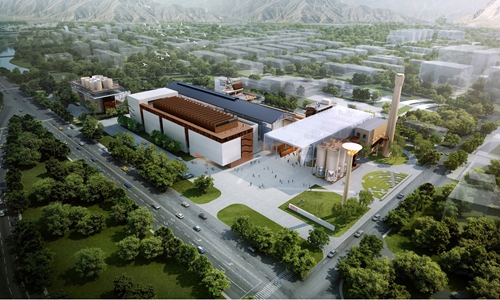HOME >> ARTS
Southwest China’s Tibet to open its first regional-level art museum
By Chen xi Source:Global Times Published: 2020/4/1 16:33:41

Bird view of Art Museum in Southwest China’s Tibet Autonomous Region Photo: Courtesy of Li Li
Southwest China's Tibet Autonomous Region will open its first autonomous regional-level art museum in July 2021 to mark the 70th anniversary of peaceful liberation of Tibet, the museum's designer announced on Tuesday.
Construction on the museum, which will occupy 47,000 square meters of land and have a building space of 32,000 square meters in the capital city, Lhasa, began on March 23. The opening in 2021 will first be limited to the main exhibition areas, with smaller areas opened later. According to a report from China News, it will be an international museum integrating digital and physical exhibitions and focusing on research, cultural communication and education.
Li Li, a professor with the College of Architecture and Urban Planning at Tongji University and the designer of the museum, told the Global Times on Tuesday that the museum will be divided into four functional areas: a main exhibition hall for exhibitions and public services, an interactive art area focused on public education, a creative space for artists and an art market section for live performances.
"Some artworks with Tibetan characteristics like Thangka will be showcased in the main hall," he said.
According to Li, the museum will be the result of renovating and expanding an abandoned industrial cement production facility in Lhasa. The enterprise that ran the facility, established by the People's Liberation Army in the 1960s to revitalize Tibet's production industry, was the first of its kind in the region.
"This will be the only provincial or autonomous regional-level art museum in China to be housed in a renovated industrial heritage building," Li said.
He added that the biggest challenge for the renovation will be to retain the building's original layout while fulfilling the complex functions required by a modern large-scale art museum, all the while integrating Tibet's regional cultural characteristics such as its production industry culture.
The estimated total investment in the museum so far is 350 million yuan ($49 million), according to Li.
Li said he spent a year and three months in designing the museum. During one of his visits with Tibet locals as he searched for inspiration, he discovered anticipation for the museum was extremely high.
He noted that one of the most interesting things is that many Tibetan house keys resemble small daggers.
Inspired, he decided to model the shape of the museum after one of these keys, which also provides its nickname - "The Key of the Himalayas."
"Most of the scenic spots in Tibet are solemn due to some religious elements, but I hope the art museum can be a relaxing and easy-going place for locals. It will also be a window that reveals the mysteries of Tibetan art to the world," Li said.
Posted in: ART,CULTURE & LEISURE,ARTS FOCUS